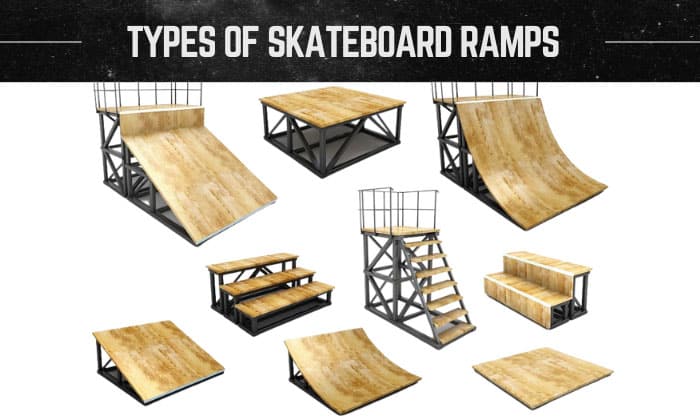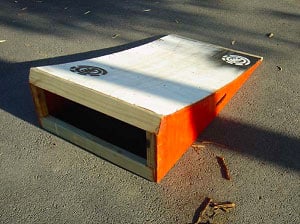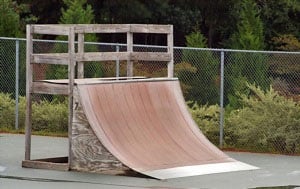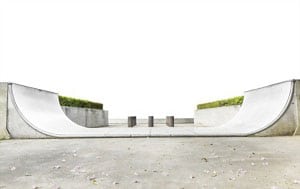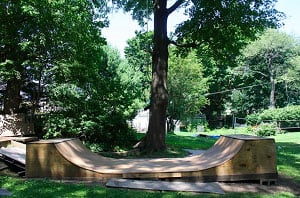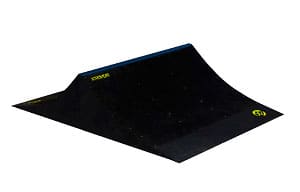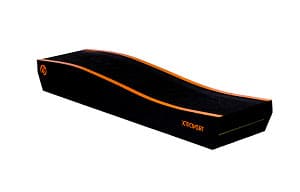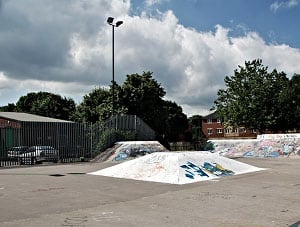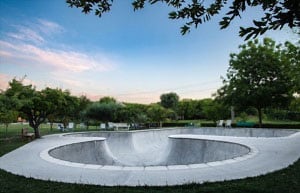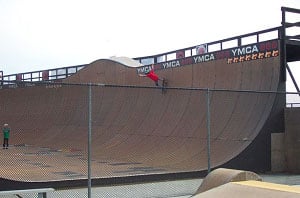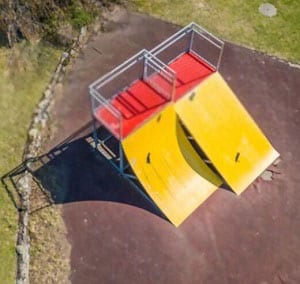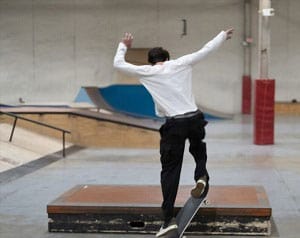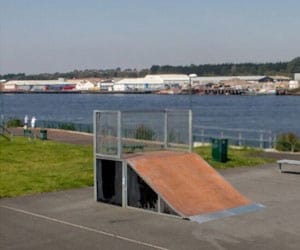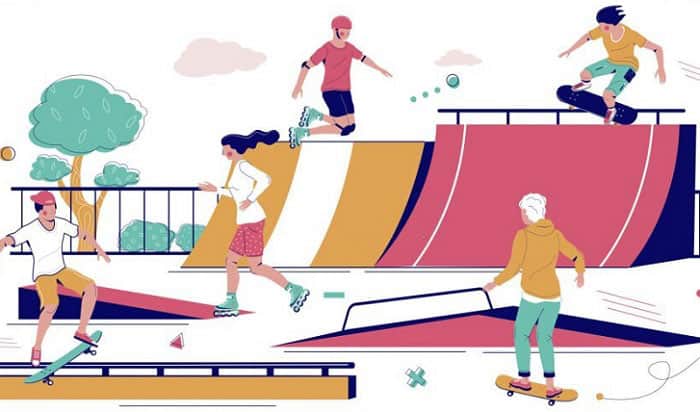As we know, skateboards do not only belong to the streets or long roads. The truth is, they also have their competition arena in skate parks.
Perhaps, skate parks are the most diverse skating spots for any rider. If you are new to skating, you may not know which obstacle to take on first. Today, we will learn about various types of skateboard ramps seen in these places and what each of them is for.
From there, you will be able to identify different types of ramps once you see them.
Table of Contents
List of Widely Known Skateboard Ramps
Skateboard ramp classifications might differ, depending on how one views them. Nonetheless, you will still be able to identify them by their design and characteristics.
1. Launch ramp
Launch ramps are the first obstacles that would give your skateboard an air-borne experience. These ramps look like inclined planes raised to a few inches in height with a slightly curved trail.
A skateboard launch ramp can be detachable or fixed. So, it’s one of the obstacles you can have in your backyard.
2. Kicker ramp
Kicker ramps look similar to launchers, only that they’re less steep. Their inclination only goes around 15° to 30°, and they may be used to ride scooters or bikes. The only potential downside of this ramp is that they yield a lower skateboard height mid-air.
Related: Making a Portable Kicker Ramp: A DIY Series
3. Quarter pipe
Quarter pipes are both fundamental and challenging. These ramps are the perfect way to upskill in doing skateboard tricks. Compared to the previous types, quater pipe ramps have a curved finish, depicting 1/4 of a round tube.
They come in various heights, and these are the most widely installed ramps in backyards. Technique-wise, these wooden skate ramps are versatile, allowing skaters to start from either the top or bottom of the obstacle.
4. Half pipe
Visually, half pipes are two pieces of quarter pipes connected by a flat base in the middle.
Half pipes are perfect for skaters who want to incorporate speed and air tricks. Riders swing back and forth, mastering their balance and control on the ramp.
Often, these ramps stand as tall as 7′ to 14′ for competition-level setups.
5. Mini ramp
Mini ramps often sit inside an indoor skate park or the backyard of a beginner skateboarder.
Often, a mini ramp looks like a halfpipe. But the most salient difference between the two rests on their sizes. This beginner skateboard ramp only stands as tall as 7′. It could also be as short as 2′. Hence, this is an ideal obstacle for young skaters learning flips or basic skateboard jumps.
6. Spine
If half pipes connect through their approach sections, the spine ramp consists of two quarter pipes linked through their back walls. Unlike the half pipe, the spine doesn’t have an extra platform connecting the quarters.
Spines are best for skaters who want to master transition tricks with sufficient momentum. They are like upward-sloping portions of a straight trail.
7. Wave ramp
At first, wave ramps look like humps on the streets. But this skateboarding fixture aims to make the rider feel like surfing on water.
Wave ramps have rises and falls, so their surfaces are curved. The high and low points of the ramp aren’t so steep that riders should exert too much effort to skate over them.
After mastering this obstacle, skaters finally manage their speed better.
8. Pyramid
Perhaps, the best way to imagine a pyramid ramp is by imagining the ones in Egypt, but without a sharp tip or peak.
Pyramid ramps are four-sided mountain-like ramps with a flat top. These ramps also have other skateboard ramp names, like double box jumps or kicker-to-kicker. Since this ramp is a four-sided variant, you may approach it from any side you want.
Try doing an ollie on pyramid ramps and see how it goes.
9. Bowl
If you want to have more fun carving, bowls are great obstacles to try out.
From the term itself, bowl ramps look like pools, only that they could be irregular or unusual in shape. When you skate here, you may experience a flat portion or a concave surface.
Skill-wise, bowl ramps help skaters attain better speed.
10. Vert ramp
If you know Tony Hawk, you might already know about this ramp.
Shaped like the letter U, a vert ramp looks close to the previous pipes we discussed. The only difference it has versus the preceding examples is an extended vertical platform at the top-most portion of the obstacle.
Such an aspect helps the skater detach off the ramp, toss themselves into the air, and land safely on the ramp.
11. Mega ramp
Mega ramps are insane versions of a vert ramp. These obstacles are often present in exhibition competitions due to their height, ranging from four to six-story levels. With these numbers, skate parks that set this up should have a lot of space.
Friendly note: Mega ramps are only for skaters skilled enough to take risks to clear the obstacle.
12. Roll in
Roll-ins are like quarter pipes, only they don’t have a metal coping at the top of the transition for sliding.
If kicker and launch ramps are preparatory for air tricks, the roll-in aims to help the skateboard gain speed.
13. Ledge ramp
Also known as the grind box, a ledge ramp looks slightly different from the previous examples because it does not have a transition or a sloping side.
This ramp comes in a box shape, often a rectangle, for a more extended grinding spot. The top corners of a ledge ramp often have a metal coping.
14. Bank ramp
Visually, bank ramps are the closest obstacles to quarter pipes. The ultimate deviation you can take note of is their transition.
Quarter pipes have a curved transition. On the other hand, bank ramps keep their slopes flat. What are the best tricks to do on bank ramps? Kickflips and other ground tricks.
Frequently Asked Questions
What are skateboard ramps?
A skateboard ramp is a skateboarding obstacle that helps users ride and perform tricks. Often, skate park ramps come in the form of slopes, ledges, rising and sinking platforms, or inclined launchers.
Ramps for skateboarding have various shapes, build, and design to support the diverse nature of the sport.
These differences help the skater master different tricks and control other aspects, like speed and balance.
What is the difference between a half pipe and a vert ramp?
As mentioned, vert ramps look close to half pipes because of their classic U shape. However, their difference rests on the shape of the transition.
Vert ramps are steep, while a half pipe has a gradual curve. The vertically sharp top end of a vert allows skaters to execute more aerial tricks while being assured of a safe landing.
Can you make your own skateboard ramp?
Absolutely! If experts can set up a skate park from rough ideas, what keeps you from making your version of a skateboard ramp?
Don’t worry if you are inexperienced because hundreds of cheap skateboard ramps tutorials are now accessible to guide you. While some parts and materials could entail costs, your finished projects will still be worth it.
All you need is to be mindful of measurements and cutting the materials at the correct lengths. By doing these things, you’ll have your first successful skate ramp.
Conclusion
Skateboarding ramps help a skater grow, learn, and master the sport. Their variations allow every rider to improve in various aspects. Hence, as skaters, never hesitate to try these obstacles.
Now that you know the different types of skateboard ramps, you can finally set up your progression plans by taking on each of these obstacles.
Some differences between ramps could be challenging to identify, but trying them could make the job easier.

Hi, I am Charles Harris. I opened this site to write as much as I can about my biggest passion – skateboarding!
I started as a clumsy yet passionate rookie 10 years ago to now a still passionate yet much better skateboarder! But I have to tell you, the whole journey has always been fun and rewarding, indeed not without hardship.


